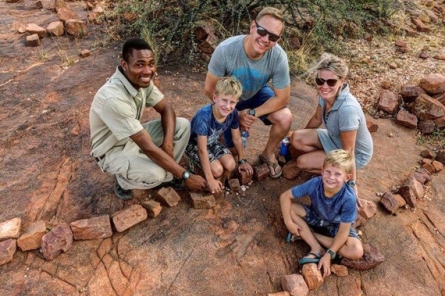
Saurichnium Damarense at Mount Etjo - German archeologists Dr Huene in 1925 and Dr Gürich in 1926 were the first to discover and describe the footprints found in the Etjo sandstone. Gürich distinguished 4 types: Saurichnium damarense, Saurichnium parallelum, Saurichnium anserinum and Saurichnium tetractis. At the Mount Etjo slope, up to three different footprints can be found. The most prominent and easily distinguishable footprint is that of Saurichnium damarense, the smaller footprints are thought to perhaps be those of juvenile Saurichnium damarense. Unfortunately not enough evidence is available to further classify these footprints. These are believed to be remnants of the Triassic (Stormberg) age and around 230 Million years old.
The necessary condition for dinosaur footprints to survive for 100 million years is that the impression has to be made in soft clay (along a lake, coastline or riverbed), and then baked dry by the sun. Assuming the footprints are "well-done" enough, they can then persist even after being buried under successive layers of sediment. What this means is that dinosaur footprints aren’t necessarily found only on the surface, they can be recovered from deep beneath the ground, just like ordinary fossils.
At the Mount Etjo footprints you will notice that these layers of sediment have weathered off over the years along the mountain range, revealing the dinosaur footprints that lay hidden and protected beneath. Take note of the different layers of red clay – they carry the same red color of the soil typically found in Namibia today.
The Dinosaur Walk
The footprints are about 3 km away from the Camp Dinosaur camping sites at Mount Etjo Safari Lodge. Follow the signs while admiring the magnificent scenery from the top of the hill.
The trail is about 1.5 km (about 30 minute walk)
- Guided Walk: N$ 300.00 Per person
- Unaccompanied Walk: Free of charge
Buffalo Footprints
In the Okonjati Pass fossilized Buffalo Footprints can be found.
Seemingly much alike the dinosaur footprints, footprints at the foothills of the Okonjati mountains, much resembling buffalo tracks of today, can be found. The tracks are embedded in in a type of limestone, which is thought to be several Million years old, a time during which no mammals existed. Many scientists have visited the site and suggested various theories to explain the source of the prints. Nonetheless, there must have been a reason why the old native Hereros gave Okonjati it's name, meaning: "Place of the Buffalo".
Ironically the majestic buffalo is the only animal which cannot be found at Okonjati Game Reserve today - Buffalo carry foot and mouth disease which is thought to be spread to cattle in the area.
